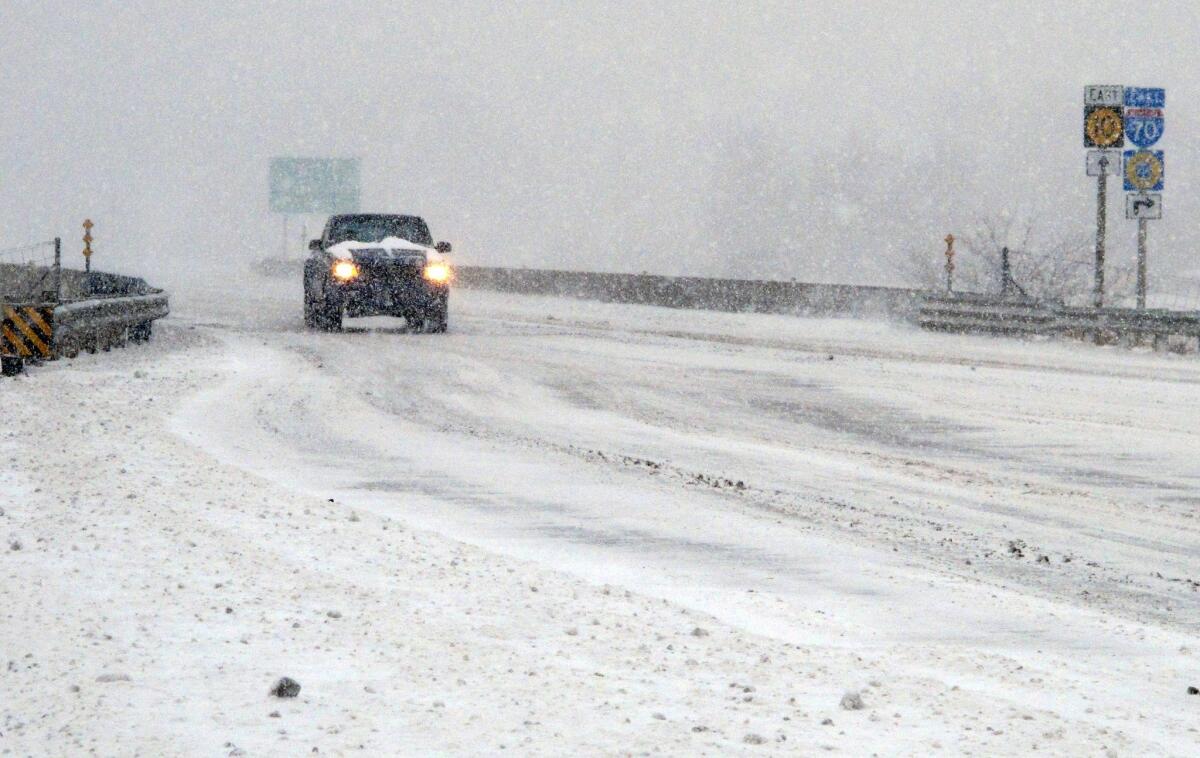Snowstorms mark winter of discontent for two-thirds of U.S.

- Share via
For as much as two-thirds of the United States, this has, indeed, been the winter of our discontent.
Even as a harsh storm was dropping as much as 10 inches of snow on parts of the Midwest, especially Kansas, that same system was moving east and was expected to make the evening commute and Wednesday’s morning drives to work in the Northeast miserable experiences.
Nor could the Northeast take comfort that the worst was over. After a snowstorm earlier this week, a third storm is gathering and is expected to hit at the end of the weekend and into the early part of Monday, proving that three of a kind is only good when playing poker.
Winter storm warnings were posted for more than a dozen states where well more than one-third of the nation’s population lives. Where there weren’t warnings, there were advisories.
“Heavy snow and freezing rain will impact the central U.S. today from the Plains into the Ohio Valley,” the National Weather Service warned. “As the system moves east, the heavy snow and ice will impact locations in the Northeast on Wednesday. In addition to the winter weather, heavy rainfall could result in flooding across the Tennessee and Ohio Valleys.”
The heavy snow closed schools throughout the region where many places were reporting that the days lost to weather were piling up almost as high as the drifts outside. Indiana, for example, has some areas where schools were closed for a full week in January because of the weather and road conditions.
The National Weather Service warned of extremely difficult driving conditions. Interstate 70, an artery linking Kansas City and St. Louis, was closed in both directions early on Tuesday near Columbia, Mo., after several accidents involving tractor-trailer trucks.
More than 3,700 flights were delayed on Tuesday, and more than 1,200 were canceled by midday, according to Flightaware.com, a website that tracks air traffic.
According to masFlight, which tracks airline costs, January was the worst month for flight disruptions in recent history. It estimated that severe weather flight delays last month cost Americans $2.5 billion in lost business and productivity.
Icy conditions were also a problem in Arkansas, where multiple accidents were reported on several major traffic arteries. Conditions were most hazardous in the northwestern corner of the state, near the borders with Missouri and Oklahoma. Power outages were also reported as ice and snow clutched overhead transmission lines and the added weight snapped the circuit.
Arkansas Gov. Mike Beebe directed that only essential state employees were to report to their jobs in the capital.
Records were buried in snow piles. Detroit, for example, recorded 39.1 inches of snow in January, a record for the month, and New York City received almost 2 feet more snow than in most other years. In Chicago, the storm marked the 33rd and 34th days of measurable snow this season, according to the Chicago Tribune.
“It’s going to be spreading north into the area, moving into the South Side of Chicago mid-to-late this afternoon, then into the rest of the area mid-to-late this evening,” said National Weather Service meteorologist Ben Deubelbeiss, whose agency has issued a winter weather advisory from 6 p.m. Tuesday until noon Wednesday.
As the snow falls, the wind will pick up with gusts of 25 mph that could whip up snow drifts during the drive home. About 2 to 4 inches of snow are expected in counties around Chicago, with less snow falling the farther north.
Temperatures will drop to below zero in some places Wednesday night, starting a stretch of three nights when the low will be in the minus figures, the newspaper reported.
Only two other seasons in the past 129 years have seen more days of measurable snowfall through Feb. 3: 33 days in 1976-77 and 35 days in 1978-79, according to the Tribune.
ALSO:
U.S. abortion rate in 2011 lowest since 1973, study says
National Guard recruiting scandal probed by Senate panel
‘Thank goodness you were a lousy shot,’ judget tells gunman at sentencing
More to Read
Sign up for Essential California
The most important California stories and recommendations in your inbox every morning.
You may occasionally receive promotional content from the Los Angeles Times.













